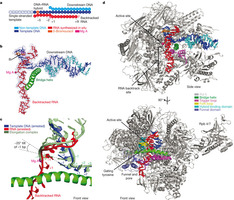Thursday, 24 February, 2011
Stop and go
How the cell deals with transcriptional roadblocks
Gene transcription is central to cell function, as it converts the information stored in the DNA into RNA molecules of defined sequence, which then program protein synthesis. The enzyme RNA polymerase II (Pol II) is responsible for this genetic readout, but is prone to transcriptional arrest. The biochemist Professor Patrick Cramer, Director of LMUs Genzentrum, and his research associate Dr. Alan Cheung have now shown for the first time and captured on film -- what happens when Pol II arrests at a roadblock. They were even able to observe how transcript is reactivated. Reactivation of arrested transcriptional complexes is a normal part of the readout process, and is therefore of fundamental significance in all cells. Indeed, as Patrick Cramer points out, It is also utilized to regulate gene activity in stem and tumor cells. (Nature online, 23 February 2011)
Presseinformation der LMU (deutsch)
Press information LMU (english)
Publication "Structural basis of RNA polymerase II backtracking, arrest, and reactivation"


